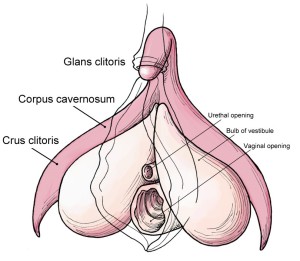 No, this post isn’t about penises or vibrators. (Why do our minds always go there!) I’ll reserve that subject for Part 2. This is about the clitoris. Yes, the clitoris, “a small erectile female organ located within the anterior junction of the labia minora that develops from the same embryonic mass of tissue as the penis and is responsive to sexual stimulation” (according to Merriam-Webster on-line dictionary). While seldom the subject of much scientific research, a recent publication* investigated the relationship between clitoral size and sexual function (including the extensive internal portion – “out of sight, out of mind” you might say).
No, this post isn’t about penises or vibrators. (Why do our minds always go there!) I’ll reserve that subject for Part 2. This is about the clitoris. Yes, the clitoris, “a small erectile female organ located within the anterior junction of the labia minora that develops from the same embryonic mass of tissue as the penis and is responsive to sexual stimulation” (according to Merriam-Webster on-line dictionary). While seldom the subject of much scientific research, a recent publication* investigated the relationship between clitoral size and sexual function (including the extensive internal portion – “out of sight, out of mind” you might say).
In a small convenience sample of women having a pelvic MRI for other reasons (such as fibroid tumors), these researchers compared clitoral size and each woman’s sexual function as measured by several validated scales. Paradoxically, women with the smallest clitorises (yes, that’s the correct pleural of clitoris), specifically the clitoral body and crus (see diagram below), had the best sexual function. Those women with a smaller clitoris tended to have better desire, arousal, lubrication, and orgasm. The authors of the study suggest that a greater density of nerves, basically squeezing the same number of nerves into a smaller space, is what leads to better function.
There are several limitations to this study, so take these findings with a grain of salt. The relatively few women who participated were having their MRIs done for other medical reasons besides participation in this sexual function study. Therefore, the findings may not actually be generalizable to all women, especially “normal” women without another existing medical condition. But, this study does give a whole new potential meaning to the oft-quoted “good things come in small packages” idea. And that’s c.o.m.e., not c.u.m! Really, does your mind always go there?
Interested in women’s sexual health? Contact us for an appointment.
* Vaccaro CM, Fellner AN, Pauls RN. Female sexual function and the clitoral complex using pelvic MRI assessment. European Journal of Obstetrics & Gynecology and Reproductive Biology 180: 180–185, 2014.
